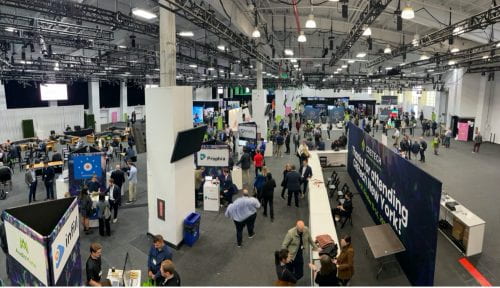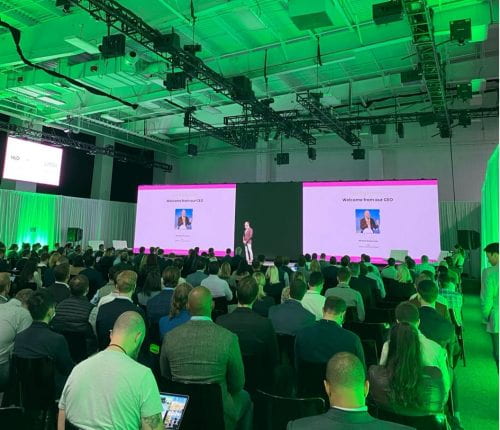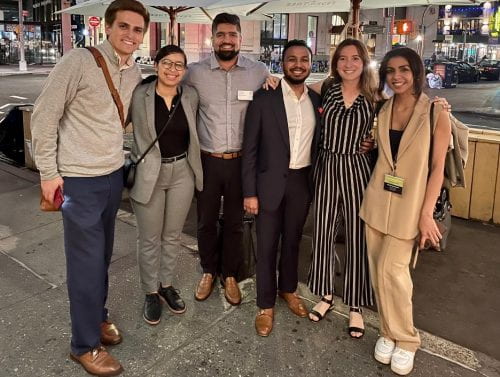The Commercial Real Estate Technology (CRETech) Conference, held in NYC on 13th and 14th October, addressed recent commercial real estate trends, key challenges currently faced in proptech, and technology solutions to make housing affordable. CRETech is the largest event to bring an international community of leading experts in technology innovation in real estate together, including company trade shows and the largest directory of proptech startups defining the future of the industry. The conference speakers presented insightful content and projected notable enthusiasm about being back in person for the conference post pandemic. As attendees, we got to hear from major development companies, brokerage firms, venture firms, and growing startups about the real estate sector’s rapidly increasing investment in digitization as a tool in solving the affordable housing crisis. However, the industry’s mission to digitize still lags due to a lack of awareness and delayed adoption.

The most recent trends in the commercial real estate technology space are surely setting discourse for the future of the industry. Michael Beckerman, the founder of the CRETech conference kicked off day one by expressing his gratitude and stating the purpose of the meeting- to connect brokers, asset managers, bankers, and innovators. Mr. Beckerman reinforced how the global CRE technology environments in global cities like NYC and London are leading indicators of progress. Boasting 1,800 participants, a list of 65+ speakers, and the greatest number of sponsors the event has ever received, the two-day conference was held at Pier 36, which was divided between 1:1 connect spaces, innovation stage, main stage, experiential exhibits, and an incubator setup for startups[1]. Andy Florance, the CEO of Costar walked us through the history of data analytics in real estate and the tremendous growth that technology has enabled through functionalities such as the introduction of thermal capabilities for energy performance, drone facilities suitable for low and high altitudes, artificial intelligence to determine complex images with deep focus, data aggregation for rental data reports, and virtual office touring for improved occupancy rates.
One of the most pressing issues addressed was that of solving the affordable housing crisis using technology capabilities. Affordable housing is an issue impacts all income levels and is compounding exponentially. Sarah Yaussi, the Vice President of Business Strategy at National Multifamily Housing Council (NMHC) presented some of the most recent industry insights and challenges in the affordable housing sector. Ms. Yaussi mentioned the challenges of archaic, complex, and time consuming zoning laws, and the need fora better marriage between policy and technology. A critical observation was how the political influence in different counties impacts the construction process, making affordable housing policy facilitation inefficient and unilateral. A recent residential project for which 30,000 applications were received for 50 units in New York City was one of the many projects under heavy political influence that caused innumerable delays in project construction and severe backlash from government zoning regulators. Colin Dunn from NMHC reported how “a record 83 percent of multifamily developer respondents reported construction delays in the jurisdictions where they operate, according to the seventh edition of the National Multifamily Housing Council (NMHC) COVID-19 Construction Survey [2].
The construction delays that existed prior to COVID due to political conflicts were heightened post COVID due to a surge in the construction costs and shortage of labor supply, making the completion of these affordable housing projects even more challenging. Additionally, there is the issue of capital gap to complete multi-family development in a timely manner. Alison Novak, head of Sidewalk Urban Development advocated the use of a centralized platform to align all parties. These programs allow the team to enter priorities, scenarios, walkability, ROI, risks, construction costs, scenario testing and affordable housing feasibility all on a singular platform, enabling transparency and efficiency of operations. Ms. Novak also described the innovation opportunities in the construction process, such as modular construction using high-fidelity digital fabrication to address inefficiency problems. Additional pre-fabrication opportunities should be used to reduce the overall cost of affordable housing units. Tyle Thompson, the managing partner at Second Century Venture mentioned the important role of automation and robotics in a multi-family construction project, such as using pre-assembled bathrooms that can be delivered within an hour, reducing costs and boosting efficiency.

Industry leaders including John Fitzpatrick, Chief Technology Officer of Alternative Asset Management Technology at Blackstone, and Brad Greiwe, the Co-Founder and Managing Partner at Fifth Wall, described how the real estate tech industry is at the cusp of impactful change driven by innovation and widespread urgency to incorporate technology capabilities, yet adoption is a struggle. There are currently 8,000+ proptech startups with $10B+ in investments[3]. There are buildings being monitored by computers to check air quality, footprint, and daily operations. But the big problem remains the lack of capital, largely due to budget constraints, lack of information, and risks associated. This makes all decision-making related to proptech challenging. Proptech advocate, Raj Singh who is the managing partner at JLL Spark, talked about lagging deployment, fragmentation, and real estate technology not being treated as a true product. Mr. Singh offered three intriguing solutions to the problems at hand. Firstly, he recommended applying an aggressive deployment strategy and a follow up evaluation of 50 different properties to measure effective solutions. For solving the fragmentation issue, he echoed , “Future is product” and products eventually turn into platforms. The process will involve multiple platforms but will end the fragmentation of users and buyer in an industry where there is a critical shortage of integrated technology usage. Lastly, Mr. Singh suggested an “open ecosystem” for engaging data analytics and EAM platforms to enable smooth operations.
Large scale events like the CRETech conference do an excellent job bringing industry stakeholders to celebrate recent industry innovations and progress, but more importantly to understand the challenges associated with the execution of technology and data within the commercial real estate industry. With increasing equity flowing from all directions towards the real estate technology industry, can the industry players adapt the technology in real time to solve urgent challenges such as the affordable housing crisis?

Sources:
[1] CREtech Blog. (2021, October 14). Over 1,800 industry professionals attend Cretechs flagship in person conference debut, from, www.cretech.com/cretech-blog/over-1800-industry-professionals-attend-cretechs-flagship-in-person-conference-debut-cretech-new-york/
[2] Dunn, C. (2021, June 9). New NMHC Construction Survey finds record construction costs and increasing delays. NMHC. Retrieved March 2, 2022, from https://www.nmhc.org/news/press-release/2021/new-nmhc-construction-survey-finds-record-construction-costs-and-increasing-delays/
[3] Redlingshafer, R. (2021, August 25). Proptech startup funding on track to break real estate industry records in 2021. Commercial real estate. Retrieved March 2, 2022, from https://www.us.jll.com/en/newsroom/proptech-startup-funding-on-track-to-break-real-estate-industry-records-in-2021
